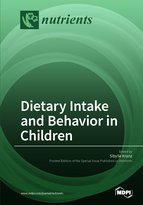Dietary Intake and Behavior in Children
A special issue of Nutrients (ISSN 2072-6643).
Deadline for manuscript submissions: closed (31 March 2017) | Viewed by 150625
Special Issue Editor
Interests: diet quality; childhood nutrition; school feeding; feelings of hunger and fullness; diet and learning; dietary guidance
Special Issues, Collections and Topics in MDPI journals
Special Issue Information
Dear Colleagues,
Dietary intake in children is not only associated with current and future health, but also with behavior and learning. Especially during early childhood throughout the school-age years, adequate food and nutrient intake to support brain development and function are critical. Furthermore, data on the effect of sugar intake on children’s activity levels, or their ability to focus on cognitive tasks, are mixed. More research in nutrition and children’s behavior is needed: How does behavior affect children’s nutrition? and how nutrition affect children’s behavior?
Dr. Sibylle Kranz
Guest Editor
Manuscript Submission Information
Manuscripts should be submitted online at www.mdpi.com by registering and logging in to this website. Once you are registered, click here to go to the submission form. Manuscripts can be submitted until the deadline. All submissions that pass pre-check are peer-reviewed. Accepted papers will be published continuously in the journal (as soon as accepted) and will be listed together on the special issue website. Research articles, review articles as well as short communications are invited. For planned papers, a title and short abstract (about 100 words) can be sent to the Editorial Office for announcement on this website.
Submitted manuscripts should not have been published previously, nor be under consideration for publication elsewhere (except conference proceedings papers). All manuscripts are thoroughly refereed through a single-blind peer-review process. A guide for authors and other relevant information for submission of manuscripts is available on the Instructions for Authors page. Nutrients is an international peer-reviewed open access semimonthly journal published by MDPI.
Please visit the Instructions for Authors page before submitting a manuscript. The Article Processing Charge (APC) for publication in this open access journal is 2900 CHF (Swiss Francs). Submitted papers should be well formatted and use good English. Authors may use MDPI's English editing service prior to publication or during author revisions.
Keywords
- dietary intake
- behavior
- eating behavior
- pediatric nutrition
- nutrition
- cognitive functioning







